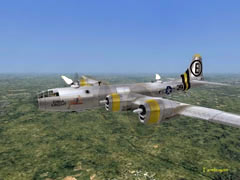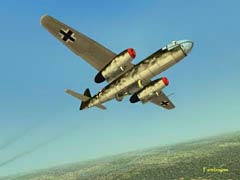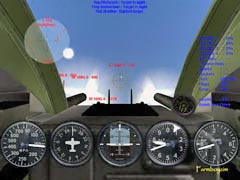


www.farmboyzimsflightsims.com
FBZFS
Click On Any Picture For A Larger View

Thanks For The Visit !



If you've already read the review of Shockwave's Wings of Power WW II Bombers and Jets, you'll already know that these are aircraft of a different breed. The "absolute realism" that they speak of is carried over into their product FirePower for Microsoft Combat Flight Simulator 3. The same amount of effort went into making these aircraft fly like the real thing. With the Firepower product, you get some of the aircraft that was included in their Wings of Power WW II Bombers and Jets package, plus a few extra.
My first sim was not a "civil" sim, but one of the older combat sims from some years ago. I was hooked on the challenges of the campaigns and air battles. Back then, a colleague of mine was into the "civilian" side of flying with the Microsoft products. Seemed pretty boring to me until I got hooked on it too! I have, admittedly, let my sites go rusty over the past year or so, only on occasion trying to blast something out of the air or off the face of the earth, so when I received
Firepower for review, my interest in Combat Sims was reignited! I'm not a violent person by nature, but it was fun to take those aircraft out of MSFS2004, and put them to use for what they were intended for...fighting!
Most of the aircraft and their characteristics were already covered in my review of Wings of Power WW II Bombers and Jets, so I'll just cover the ones that are added in for your fighting pleasure! The following excerpts are from the Manual (in MS Word format) and includes some interesting information on the aircraft that are in the package:.
DeWoitine D.520 Fighter
The DeWoitine D.520 is generally held to be the best French fighter of World War II. Utilizing a Hispano-Suiza 12-cylinder power plant producing 930 PS (916 HP) for takeoff, this fighter -- although substantially slower than the Me 109s it was opposing -- proved very capable in a turning and diving fight. The D.520 packed a serious punch in the form of 4 7.5 mm machine guns and a single 20 mm cannon firing through the propeller hub. It was very agile and dove well, with well-harmonized controls that were light to the touch. An experience pilot could get on an enemy's tail very quickly if his opponent did not take appropriate evasive action. However, once out of diving altitude, the D.520 could be run down fairly easily by the German Messerschmitt, and then had to rely on its agility to jink and roll its way out of trouble. Overall, the D.520 was an excellent, if underpowered, fighter that gave a good accounting of itself in the short time allotted to it during the Battle of France. Once the Germans took over the French air industry, the type was relegated to trainer status and saw service in a variety of arenas until war's end.
Dornier Do 217
History:
The Dornier Do 217 was a late development of the original Do 17 "Flying Pencil" twin-engine bomber of Battle of Britain renown. The Do 217 N-2 was the latest and most potent of all the 217 series. Towards the end of 1941, the German General der Nachtjagd steadily added links to the defensive chain, which had become known as the “Kammhuber Line.” This defensive grid comprised a searchlight belt of 22 miles in depth for illuminated interceptions and zones which individual night fighters were vectored towards their targets by the Himelbett system of ground control. By May 1942, the slower, poorly defended British bombers were giving way to the new, more potent warplanes such as the Lancaster, which debut in March 1942. British night raids were becoming increasingly more effective, with devastating attacks like the first “Thousand Bomber” raid on Cologne on May 30-31, 1942. The Germans generally considered the Ju-88 to be the best aircraft available for night fighting, with destructive forward firing armament, excellent performance, and the endurance necessary for standing patrols. Unfortunately, the vast majority of Ju-88’s coming off the production lines were committed elsewhere. Thus, the BF110 had to shoulder the burden of defending the night skies, despite it also being in very short supply.
It was consequently proposed, that the Do 217 heavy bomber, despite its size and weight, be adapted as an interim night fighter. Deliveries of the newly converted Do 217J-1 night fighters began delivery in March 1942 and by July 1942, the Do 217N-1 appeared in the skies with new on-board radar equipment. The 20mm MG FF cannons were replaced with the higher velocity 20mm MG 151’s. Another modification introduced in the DO217N-1 was adding two upward firing “Schrage Musik” 20mm MG 151 cannons in the rear fuselage.
The success of the “Schrage Musik” configuration resulted in the design of the Rustsatz field conversion set for the installation of four 20mm MG 151’s in the upward firing position. This model was then designated the Do 217N-2. The Do 217N-2 night fighters began to appear over a wide area during the course of 1943. During the early months of 1944 all Do 217 night fighters began to disappear from the night skies. Production of all versions of the Do 217 night fighter had totaled 364 aircraft delivered during 1942 into early 1943.
Messerschmitt Me 334 Interceptor
This was a design for a small tailless fighter, based on the wings of the Me 163, but with a Daimler Benz DB 605A 12-cylinder piston engine instead of the rocket engine of the Me 163. The wings were mounted mid-fuselage and were swept back at a 23.4 degree angle. The engine was installed in the nose, but drove a pusher propeller on the tail. The Me 334 would also have had a tricycle undercarriage and a ventral fin. The main landing gear retracted inwards and the front gear retracted to the rear. Intended armament was to be two MG 131 13mm machine guns. When the rocket engine for the Me 163 was ready the Me 334 was abandoned.
This design was clearly a stopgap solution and would not have been a very good fighter. With the addition of the large, heavy engine in the plane's nose, coupled with the tremendous torque of the pusher propeller, it would have been very difficult to fly and would have required a good deal of retrimming as airspeed changed, particularly with respect to rudder and aileron trim. Changing the powerplant from a jet to a propeller would have had drastic effects on the handling. This "What if?" aircraft reflects this fact and portrays the plane as it most likely would have flown had it been produced, as a somewhat desperate attempt to reach the Allied bombers and shoot them down at any cost.
Me 410
History:
The Me 210 was the result of a call to Messerschmitt to create a successor to the popular and effective Bf 110 long range fighter and bomber destroyer. The first prototype flew on September 5, 1939. The aircraft was plagued with a myriad of handling difficulties including some vicious stall tendencies. Messerschmitt began a series of modification programs to address the many serious issues encountered during trials. Plans for the Me 210 to replace the Bf 110 were all but abandoned by late 1941 when the Me 210 was still pronounced to be totally unsuitable for operational units.
The decision to stop production wasn’t official until April 14th, 1942. Despite this order, development and testing continued, and consequently the most serious issue of poor stability was somewhat resolved. Much money was lost during this long period of troubled development, so for partly political reasons, the project was assigned the designation Me 410.
The Me 410 made its appearance over Britain in June, 1943. With the 210’s stability issue improved, the Me 410 was a solid performer, and through many variants, gave the Luftwaffe a formidable heavy bomber interceptor, and ground attack platform. By the end of 1943, 457 Me 410’s were delivered to the Luftwaffe. While the Me 410 scored a considerable amount of daytime bomber kills, it was still vulnerable to the latest single-engine Allied fighters.
Curtiss P-40N Warhawk
Based on the Curtiss P-36, which used an air-cooled radial, the XP-40 was first flown in October of 1938. From this humble beginning came an aircraft that has become one of the most recognized fighter planes of World War II. Almost everyone knows of the "Flying Tigers" who flew under General Claire Chennault, with their distinctive shark-mouth nose art and jutting, massive spinners. It was this service that initially brought the P-40 to the public's attention, but the P-40 in fact flew in every theatre of war and gave a good accounting of itself, despite more modern opposition.
A rugged, attractive plane, the P-40 could take quite a lot of damage and still make it home. And while it was considered to be the most maneuverable of the Army Air Force fighters by many pilots who flew the type, the Japanese fighters were lighter and could out-turn the heavy P-40. But the Warhawk was faster and better-armed, and could easily leave the Japanese planes behind in a dive.
Focke-Wulf Ta 152 C-1/R31 and the Focke-Wulf Ta 152 H-1
History:
Focke-Wulf Ta 152 C-1/R31
The Focke-Wulf Ta 152 series was considered Kurt Tank's crowning achievement with respect to the development of a high altitude reconnaissance fighter and interceptor. The Ta 152 was similar in general layout to the Fw 190D, as it used a liquid-cooled inverted V-12 for motive power. But the airframe was considerably different. The wings were slightly larger and the fuselage and tailplane were significantly improved and modified. In addition, the nose was further streamlined and the aircraft was fitted with a bubble-type canopy for better pilot visibility. The Ta 152 C was the first production version of the series. It had an increased fuel capacity of 280 U.S. gallons total in the wings and fuselage, and was fitted with a Daimler-Benz DB 603L which used the MW50 methanol-water injection to increase takeoff power to 2,100 HP. This aircraft was considered a medium-altitude fighter and was undoubtedly one of the finest fighters to emerge from World War II. It retained the superb roll rate of the Fw 190 but with greatly increased power and range.
Only a few Ta 152 C-1/R31 aircraft entered service in April 1945. This outstanding fighter was highly maneuverable and well-armed, but probably never used in combat. It was the final model of the Focke-Wulf Fw-190 series. Equipped with Rustsatze R31, it would have served well as an all-weather low and medium level fighter and fighter-bomber.
Focke-Wulf Ta 152 H-1
The Ta 152 H-1 was similar in general layout to the Fw 190D, as it used a liquid-cooled inverted V-12 for motive power. But the airframe was considerably different. The wings were much larger and the fuselage and tailplane were significantly improved and modified. In addition, the nose was further streamlined and the aircraft was fitted with a bubble-type canopy for better pilot visibility, and the cockpit was pressurized. The Ta 152 H-1 is considered to be the definitive version of the series. It had a fuel capacity of 260 U.S. gallons total in the wings and fuselage, and was fitted with a Junkers Jumo 213 E-1 engine which used both the MW50 methanol-water injection and the GM-1 nitrous oxide injection to increase available power at both high and low altitudes. This aircraft was designed as a high-level reconnaissance fighter and interceptor. It did not have the fast roll rate of the Ta 152 C owing to the drastically increased wingspan, but the trade-off was the aircraft's very high operational altitude -- its ceiling was over 48,000 feet and it could reach a top speed of 472 miles per hour at 41,000 feet with the GM-1 boost.
Shockwave Productions
FirePower
For MSCFS 3
Reviewed by Farmboyzim
I am fast becoming a very big fan of the World War II era aircraft that Shockwave develops! The looks of the aircraft are not quite the same quality as that in MSFS 2004, which is probably due to the fact that MSFS2004 and MSCFS3 are two different animals with different programming, but the aircraft are still very nicely rendered, nonetheless. The flight modeling, aircraft performance and characteristics were of the same high quality that I have come to expect from Shockwave! These models are hands down superior to those that are default to CFS 3.
I couldn't get over the loads of aircraft that are included in this package. It covers most of the more important history making aircraft that were utilized by the USA, Great Britain, and Germany during the war, and a couple that didn't quite beat the timeline. These can be found in the "what If" category in CFS3.
Concerning the flight dynamics of the FirePower aircraft, they are modeled to be flown, "by the book" as the folks at Shockwave continue to emphasize. Each of the aircraft in the package displays their own particular traits, and must be flown accordingly, if the realism settings are on high. Do some research and read the LOADS of information that you can


find in your Start, Programs, Firepower for CFS3 menu. Before you start the engines, hit the F1 key and read about the aircraft you are about to fly. The information you read will correspond precisely to the aircraft you are in. FirePower aircraft are modeled for maximum realism in both how the aircraft flew and the damage that they could inflict and also take.
The ability to jump from Pilot, Copilot, Bomber, and various Gunner positions made the challenge of aerial combat even more real. Before I started "playing" these combat sims, I would watch film footage from WW II and see the gunners in the B17's, B24's and other heavy bombers with gunner positions and I would think to myself how hard would it be to hit a fighter that is screaming at you head on with closing speeds in excess of 500 mph. Extremely hard! Sure, you have a heavy machine gun spitting 550 .50 caliber slugs per minute, but remember, you’re on a moving aircraft trying to hit another moving aircraft at very fast speeds, and they're shooting back at you to boot! Not a large amount of enemy aircraft were shot down in this manner, although a few were unlucky enough to be on the receiving end of those formidable .50 cals.!

The interiors of all the aircraft in the FirePower package are rendered very realistically, with a good amount of avionics for you to utilize. All panels and gauges are very readable in both the 2D and VC modes. The flight decks and the interiors of the aircraft are where I noticed the big difference between the default and the Firepower aircraft.














The damage effects to the aircraft and to the targets, as well as the weapons effects have been enhanced to a degree of realism that is sort of chilling. As your aircraft is going down, the fire effects and the parts and pieces falling off your aircraft add to the intensity of what you are trying to accomplish, or rather failed to accomplish! I'd like to say that I let myself get shot down just to get the pics, but honesty prevails...I got blown out of the sky!







Fifty missions have been added with FirePower, along with 14 aircraft. You will also be able to fly the 25 missions of the Memphis Belle in that legendary B17. The aircraft were designed with the help of actual warbird pilots to ensure the realism factor was authentic. Along with the expert help from actual pilots, military test data and combat footage were also utilized in the development of this product. The Shockwave website has a wealth of information on the aircraft and the missions, and is an invaluable resource.
The FirePower for CFS3 is downloadable from the Shockwave website online store, and is 180 Mb in size. I had absolutely no problems with the download and installation. The package price is $29.99 USD, and is well worth the price! I think this is an extremely fair price for what you're getting in this package. If you're into the combat sims and a fan of MSCFS3, these aircraft will add loads of quality and fun to your air combat adventures. The challenge of flying these aircraft by the book is as fun as flying the missions! The bottom line is that this product has sparked that old, original interest in combat sims again, and I'm having a blast, literally and figuratively, with it!







Like I said earlier, there is a wealth of information about this product and the aircraft on the Shockwave website, and you can visit them by clicking HERE.



































